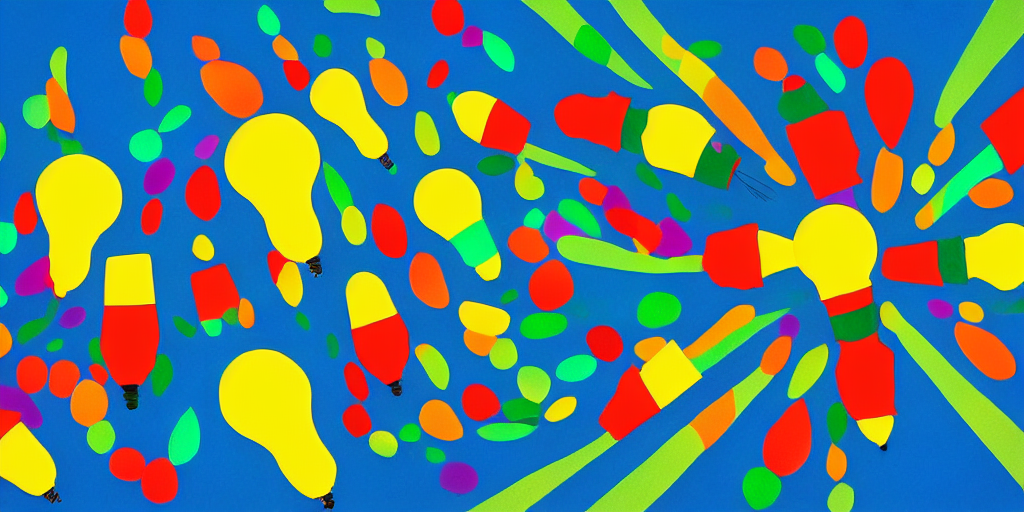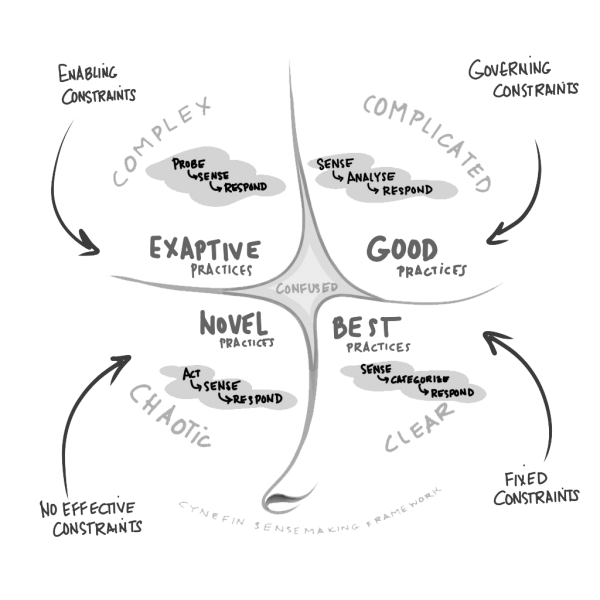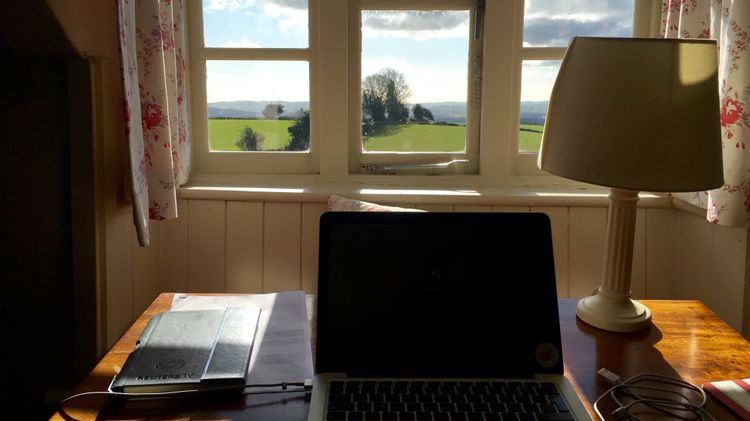Why we need freedom of initiative

This is one of the missing pieces of the puzzle that elevates creative knowledge work beyond remote (freedom of place) or async (freedom of place and time).
If you've been having problems in your team or organisation with remote or hybrid work, this article is likely to give you a few insights as to why.
To work in different places, at different times, we also need to relax some other constraints too, otherwise the system either grinds to a halt or descends into chaos.
And it's worth pausing to reflect that the key words in that sentence is 'system'.
Free-Range Work is heavily informed by systems thinking — "a way of making sense of the complexity of the world by looking at it in terms of wholes and relationships rather than by splitting it down into its parts. It has been used as a way of exploring and developing effective action in complex contexts."
Remote work looks at work by splitting it into parts and focusing on one: I used to work at the office. I now want to work at home. To enable that I'll use a chat app and a video app.
But that loses sight of the fact that creative knowledge work is a complex system of interactions with multiple other people with disparate skillsets, and collaboration on a shared objective in a mutually agreed way.
By ignoring the system, we trigger effects in the system that we're not aware of, let alone able to influence. People start to feel distant and mistrusting. Communication gains friction. People annoy each other and disunity emerges. Work gets bogged down waiting for others. Productivity slows. Expectations diverge.
So it's important that we look at the whole system. By understanding the context, we can design a way of working that allows people to act as effectively as possible in that system.
Looking at the context
To help us understand the context we are operating in, there's a framework called Cynefin (a Welsh word that roughly means 'habitat').

This shows us that there are five contexts to consider. They are differentiated by the nature of the relationship between cause and effect. Let's take a (simplistic) look at the domains and how they apply to our thinking about our kind of work...
Clear
In this context the nature of the work being done is simple, the situation is stable, and anyone with some basic training can do the work. Actions have predictable effects.
For example, being a supermarket checkout operator. The work is managed by having best practices. These are effectively rules where there is a clear right thing to do in each case ('Weigh all fruit and vegetables. Open egg boxes to check for breakage. Check the age of anyone buying alcohol...') and fixed constraints ('You can't give discounts or negotiate prices with customers. You must work onsite. Your shift is between these times. Your till must balance at the end of the shift.')
It's like playing a game of Top Trump cards. You can be trained how to play the game fairly quickly, and in each round you can quickly assess the cards played and which of your cards to play.
The approach for working in this context is:
- Sense: establish the facts
- Categorise: decide what best practices need to be applied
- Respond: apply the best practices, or escalate to a supervisor
Very little creative knowledge work happens in this context.
Complicated
This is the context in which most professional or skilled work happens. The work can be carried out by people with extensive training. For example, being an accountant, lawyer or engineer. The work is managed by having good practices, which differ from best practices by the fact that there is often a range of possible approaches to any situation, and it needs training and experience to decide which to apply. There is a solid relationship between cause and effect, but it needs analysis or expertise to understand it.
It's like playing a game of chess. With enough training and practice you develop the knowledge of the strategy needed to succeed, and are able to analyse the state of the board, generate a range of options for your move, and decide which move to pick.
The approach for working in this context is:
- Sense: Identify what the situation is
- Analyse: Use expertise to explore the situation, define the problem and identify the possible ways to proceed
- Respond: Apply the relevant good practice
Some creative knowledge work happens in this context, but often only after an initial period in the complex context has defined separate parcels of work to be done that are then only complicated.
Complex
This is the domain in which most creative knowledge work happens. Other situations that tend to be in this context are financial markets, battlefields and natural ecosystems.
But another environment that is in the complex domain is organisational culture — any group of human beings collaborating on something. There are so many connections between individuals, with different experiences, skills, emotions and thoughts involved that it's not possible to completely predict the effect from any particular cause over a period of time.
The link between cause and effect can't be reliably predicted, it can only be determined in retrospect by looking at what happened. But also, the existence of that cause and effect then changes the system slightly, so the same cause may not produce exactly the same effect again and once again can't be accurately predicted.
A complex domain is like playing a roleplaying game like Dungeons and Dragons. Beyond the rules and guidelines of gameplay, and beyond learning techniques and strategy, you need imagination, creativity and collaboration.
The approach for working in this context is:
- Probe: Conduct multiple (parallel) small, safe-to-fail, experiments or trials of activities/interventions
- Sense: Identify which intervention(s) have positive effects, identify patterns, and what lessons to draw from those
- Respond: Apply the lessons learned (and go back through probe-sense-respond as you iterate towards the desired outcome)
Most creative knowledge work takes part in this context, at least initially. However, because organisational cultures are complex environments, even the work in a complicated context takes part within a complex container.
So complexity is always involved in our work.
Chaotic
This is the context of emergencies and catastrophes. From natural disasters and terrorist attacks to financial crashes. But often, failing organisations and projects have fallen into this context too.
In this context there's no clear link between cause and effect, and the situation is too fluid and chaotic to allow time for a sensible evidence-based response. There's no time for any research or discussion. The leader just has to communicate top down, issuing instructions. No response will be perfect, you're just trying to stop it getting worse, and then restore some kind of order.
It's like a game at a toddler's birthday party after they've all had lots of sugar and excitement, there's a power cut, the only other adult has got a hangover, and then you discover the hard way that one of the children has a nut allergy you didn't get told about.
The approach for working in this context is:
- Act: Take charge. Do something, anything to try to restore at least some order.
- Sense: See what the result was and where stability might be achieved
- Respond: Take small decisive steps to turn the chaotic into the complex
Confused
This is when you don't know what context you are operating within, or you are mistaken about which context you are in. It's hard to know when you're in the confused domain, so the first hurdle is to step back and recognise it. Then, break down the situation into its parts and assign them to one of the other four domains, and treat them accordingly.
Designing work for the Complex domain
So most of our work, and our working life, happens in the complex domain. We need to design the way that we work to better suit this domain.
Two books provide us helpful insight into some of the extremes of working with complexity:
- Turn the ship around! by Captain L. David Marquet
- Team of Teams, by General Stanley McChrystal
Marquet commanded a nuclear submarine. McChrystal took command of the Joint Special Operations Task Force in Iraq in 2003. These are both environments where people expect there to be a command and control environment, with everything dictated by orders from above being obediently carried out by those below.
Indeed, each of these leaders arrived into organisations that operated just like that. But the organisations and teams were failing. Failing on every level, by every measure.
In Iraq, the might of the biggest and best-equipped armed forces in the world were being bested by small rag-tag cells of a terrorist organisation operating out of caves.
In the submarine, there was a lack of engagement, pride in the work, and care over details, that led to mistakes and crises.
Both leaders understood that it wasn't the people that were at fault, it was that the operating model wasn't suitable for the context.
"I began to view effective leadership in the new environment as more akin to gardening than chess. The move-by-move control that seemed natural to military operations proved less effective than nurturing the organization—its structure, processes, and culture—to enable the subordinate components to function with “smart autonomy."
— General Stanley McChrystal, Team of Teams
So each leader began to adopt the operating approach that suits the Complex domain, releasing the tightly held reins of control, and equipping their teams with an understanding of the purpose, desired outcomes and operating parameters.
They would focus on building clarity about the shared purpose, the desired outcomes and any constraints or parameters for working. But then they would give a huge amount of freedom to the forces personnel in the heat of the action.
"The goal of a leader is to give no orders. Leaders are to provide direction and intent and allow others to figure out what to do and how to get there."
— L. David Marquet, Turn the Ship Around
In both cases they saw startlingly positive responses very quickly, and then began to push control even further down to the front line:
“Eventually a rule of thumb emerged: “If something supports our effort, as long as it is not immoral or illegal,” you could do it. Soon, I found that the question I most often asked my force was “What do you need?” We decentralized until it made us uncomfortable, and it was right there—on the brink of instability—that we found our sweet spot.”
— General Stanley McChrystal, Team of Teams
Some of the key lessons they, and other organisations, have learned about operating effectively in complex environments is:
- Trust people. Put in place the communications, culture and regular points of connection that enable them to build trust in each other
- Provide a clear purpose and focus your work as a leader on aligning people towards that purpose
- Move the authority to where new information gets discovered, rather than moving the information to where the authority is held
- Unclog the system, and people's time and attention, by removing the need for approvals for all the small stuff
- Remove rules and strict processes as much as possible, setting parameters and guidelines instead
- Don't seek to maximise efficiency, maximise effectiveness
Theirs is a line of work where lives are literally at risk on a daily basis, as well as the fate of nations.
If they can relinquish command and control, top-down management, and give such freedom of initiative to those who do the work, I think we can too.
Free-Range
In previous posts we've established that our work can be done well from anywhere. And we can also work well at flexible and different times from each other.
But to achieve this successfully and sustainably, we must also have much more control over the way we work. and the decisions that need to be made in our work. The people closest to the
In creative knowledge work, that means we need to leave our teams free to use their initiative to:
- Decide how to organise in teams
- Decide on the work to be done, and prioritisation
- Decide on how to collaborate
- Decide what expenses need to be incurred
- Decide how to engage with others outside the team
- Decide when and where to meet
- and more
We call this Free-Range Work, with three key freedoms balanced by three key responsibilities — all aimed at building the trust and collaboration that powers creative knowledge work.
The Free-Range Work manifesto says of Freedom of Initiative:
We are free to decide what to take on, how to prioritise, how we do the work, who we collaborate with, and more. We are proactive in identifying opportunities to improve the way our team and organisation works, and acting on them. We are entrusted with decisions about our work that would traditionally have needed approvals from managers. We are provided with all the information we need to make good decisions.
In future posts here, I'll explore ways to achieve this freedom of initiative.





